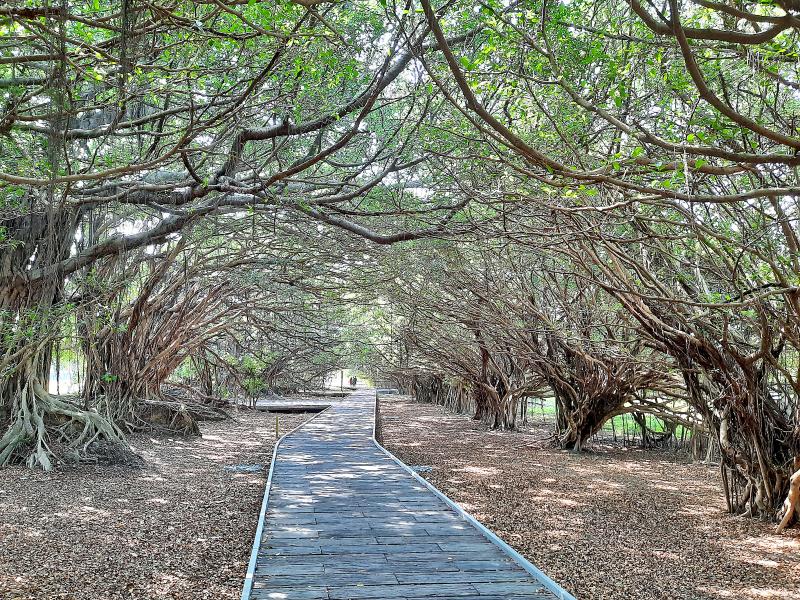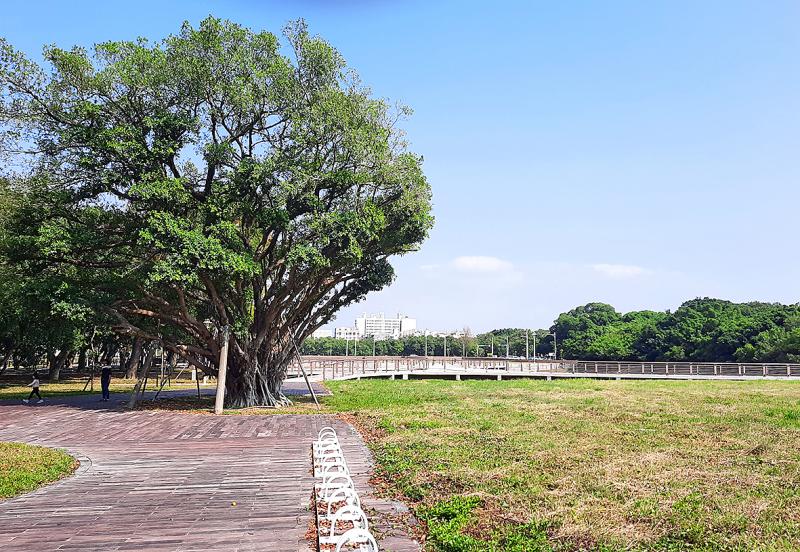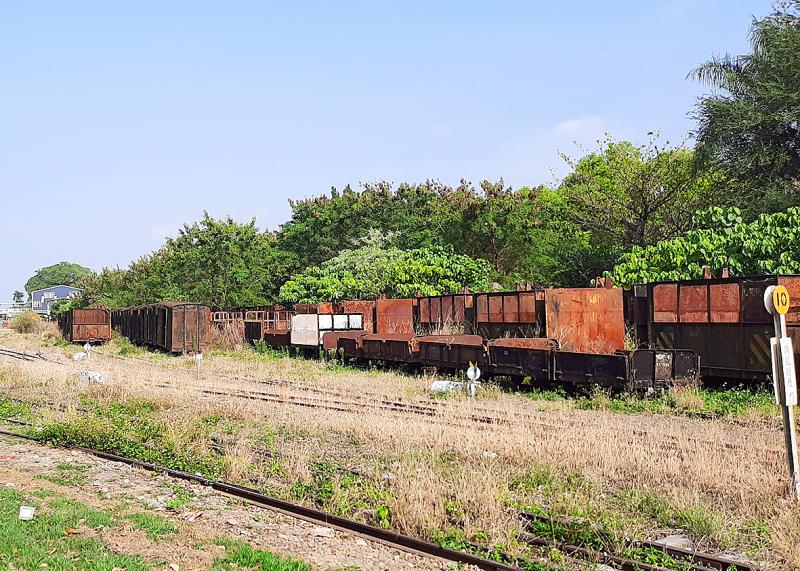The downsizing of Taiwan’s armed forces over the past two decades has freed up lots of land, some of it prime real estate.
During the late 1990s, Taiwan was defended by around 450,000 servicemen and women, many of whom were conscripts. According to an article published in Foreign Policy just over a month ago, the Ministry of National Defense (MND) currently budgets for 188,000 personnel in all branches of the military, and almost one-fifth of those positions are unfilled.
In addition to the closure or relocation of several bases, almost all the low-rise neighborhoods in which soldiers and their families lived (known as military dependents’ villages, 眷村) have been cleared.

Photo: Steven Crook
Around 5km east of Tainan Railway Station (台南火車站), Pingshih Park (平實公園) covers one part of what used to be a sprawling military dependents’ village. Another part of the village has become a parking lot for Tainan TS Dream Mall (南紡購物中心), while developers have begun preselling residential units they plan to build on the remaining plots.
Scores of mature trees have been left in place, but many others are doomed. What could have become, if simply left alone, a “green lung” on a par with Aozihdi Forest Park (凹子底森林公園) in Kaohsiung, will instead be sliced up for profit. If Tainan needed extra houses, I’d find this more understandable. But there’s a huge number of unoccupied houses and apartments throughout Taiwan — an estimated 1.2 million, according to a 2017 Ministry of Interior survey.
When Tainan City Government announced the opening to the public of the former Changsheng Barracks (長勝營區) earlier this month, I decided I should see it sooner rather than later. Chinese-language media say that 63 percent of the 11.34-hectare site in Sinying District (新營區) will be opened up for commercial and residential projects. Development may well commence before the end of the year.

Photo: Steven Crook
Between the late 1970s and its closure in 1999, the base served as the main training ground for the army’s signal corps. Since the army moved out, the authorities have been planning, demolishing, and tidying.
Apart from the lack of public bathrooms — a very surprising omission — it’s as well done as most government projects in this country, which is to say pretty good. Officialdom does things right, more or less, if often very slowly and not all that cheaply. Of course, the government’s response to the ongoing COVID-19 crisis shows it’s capable of moving fast when lives depend on it. On the subject of COVID-19, the former Changsheng Barracks wasn’t crowded, even on a pleasant Sunday afternoon. You can enjoy a good stroll here without breaching “social distancing” etiquette.
According to the Liberty Times, the Chinese-language sister newspaper of Taipei Times, renovations and preparations cost a total NT$24.15 million. The same article points out that 37 trees were relocated, but the majority were left in place.

Photo: Steven Crook
For many visitors, the most interesting trees are the Chinese banyans that form Changsheng Barracks Green Tunnel (長勝營區綠色隧道). It’s said that this canopy was purposely created to hide tanks from aerial reconnaissance. I’m not sure that’s true. The M48 and CM-11 Brave Tiger tanks which used to be the backbone of Taiwan’s army are about 3.1m high, so it would have been a very tight fit.
Through the tunnel and beyond, a boardwalk has been added to protect the ground from erosion, and to ensure visitors don’t get their shoes muddy.
Mango trees provide much of the cover elsewhere on the former base. At the time of our visit, less than a week ago, the ground was littered with green and yellow mangoes, many part-eaten by squirrels. The single mahogany tree was a center of attention, thanks to its glorious yellow-green leaves.
The only buildings preserved on the site are a smallish rectangular structure formerly used to store ammunition, and two sentry boxes on the northern perimeter.
Back when this was an active military base, access was no doubt difficult. Nowadays, no fence encloses the site, and it’s open 24 hours daily.
At the center of the site, a substantial area has been excavated to create a flood detention basin. Local families make the most of the curving concrete platform that covers part of the basin. It’s an ideal spot for riding bikes or rollerblading.
A trip to Changsheng Barracks can be combined with a look at Sinying Taisugar Railway Cultural Park (新營鐵道地景公園), also known as Sinying Railway Scenic Park (新營鐵道地景公園). As with the old barracks, there’s no admission charge.
Like almost every other sugar-making facility in Taiwan, the refinery here ceased operations years ago. However, much of the industry’s narrow-gauge railway infrastructure remains in place. There are extensive sidings, plus lots of old rolling stock. Visitors are free to wander across the tracks and among the rusting wagons. If you decide to explore, do so cautiously. Hidden in the undergrowth, there’s plenty that can trip you up.
Steven Crook has been writing about travel, culture, and business in Taiwan since 1996. He is the co-author of A Culinary History of Taipei: Beyond Pork and Ponlai, and author of Taiwan: The Bradt Travel Guide, the third edition of which has just been published.

Most heroes are remembered for the battles they fought. Taiwan’s Black Bat Squadron is remembered for flying into Chinese airspace 838 times between 1953 and 1967, and for the 148 men whose sacrifice bought the intelligence that kept Taiwan secure. Two-thirds of the squadron died carrying out missions most people wouldn’t learn about for another 40 years. The squadron lost 15 aircraft and 148 crew members over those 14 years, making it the deadliest unit in Taiwan’s military history by casualty rate. They flew at night, often at low altitudes, straight into some of the most heavily defended airspace in Asia.

Many people in Taiwan first learned about universal basic income (UBI) — the idea that the government should provide regular, no-strings-attached payments to each citizen — in 2019. While seeking the Democratic nomination for the 2020 US presidential election, Andrew Yang, a politician of Taiwanese descent, said that, if elected, he’d institute a UBI of US$1,000 per month to “get the economic boot off of people’s throats, allowing them to lift their heads up, breathe, and get excited for the future.” His campaign petered out, but the concept of UBI hasn’t gone away. Throughout the industrialized world, there are fears that

Like much in the world today, theater has experienced major disruptions over the six years since COVID-19. The pandemic, the war in Ukraine and social media have created a new normal of geopolitical and information uncertainty, and the performing arts are not immune to these effects. “Ten years ago people wanted to come to the theater to engage with important issues, but now the Internet allows them to engage with those issues powerfully and immediately,” said Faith Tan, programming director of the Esplanade in Singapore, speaking last week in Japan. “One reaction to unpredictability has been a renewed emphasis on

Taiwan’s democracy is at risk. Be very alarmed. This is not a drill. The current constitutional crisis progressed slowly, then suddenly. Political tensions, partisan hostility and emotions are all running high right when cool heads and calm negotiation are most needed. Oxford defines brinkmanship as: “The art or practice of pursuing a dangerous policy to the limits of safety before stopping, especially in politics.” It says the term comes from a quote from a 1956 Cold War interview with then-American Secretary of State John Foster Dulles, when he said: ‘The ability to get to the verge without getting into the war is